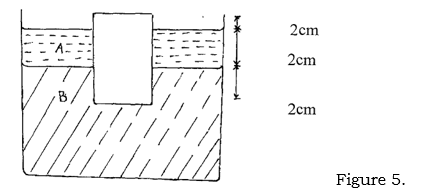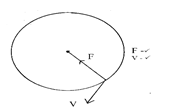Instructions to candidates
- All working must be clearly shown.
For examiners use only.

QUESTIONS
SECTION A (25 MARKS)
(Take g=10N/kg or 10m/s2)
- Figure 1 below shows the reading from a micrometer screw gauge that has a zero error of –0.25mm. What is the actual diameter of the object. ( 2mks)

- Two table tennis balls hang at the same level suspended from a thread a short distance apart. A stream of air is blown between the balls. State and explain what happen to the balls. (2 mks)
- Give a reason why heat transfer by radiation is faster than heat transfer by conduction. (1mk)
- Distinguish between density and relative density (1mk)
- State and explain how the motion of the smoke particles changes when the temperature inside the smoke cell is lowered. (2mks)
- On the axes provided sketch density-temperature graph, when water is heated from a temperature of 0°C to 10°C. Show the temperature at which water has the highest density. (2mks)

- A uniform metre rule whose mass is 150g is balanced by suspending a 10g mass and a 20g mass on its ends as shown in figure 2 below.

Determine the position of the pivot. (3mks) - Figure 3 below represents a simple fire alarm. Explain how it works. (3mks)

- Figure 4 below shows a section of a pipe with different cross-sectional areas. If water flows with a velocity of 5m/s in section A, what would be the velocity of water in section B? (2mks)

- State two factors that would raise the boiling point of a liquid. (2mks)
- A car of mass 1500kg negotiates a level roundabout of radius 40m at a speed of 72km/h. Calculate the centripetal force acting on the car. (3mks)
- A spring of elastic constant K has its length increased from 4.00m when unloaded to 4.25m when loaded with a 75N weight. Assuming that the elastic limit is not exceeded, determine the value of K. (2marks)
SECTION B (55 Marks)
-
-
- State the law of flotation (1mk)
- Explain why a hollow metal sphere floats on water while a solid metal sphere of the same material sinks in water. (2mks)
- Figure 5 below shows a uniform block of uniform cross-sectional area of 6.0cm2 floating on two liquids A and B. The lengths of the block in each liquid are shown. Given that the density of liquid A is 800kg/m3 and that of liquid B is 1000kgm-3 determine the:

- Weight of liquid A displaced (2mks)
- Weight of liquid B displaced (2mks)
- Density of the block (3mks)
-
- Figure 6 shows a fair ground ride trolley M of mass 120Kg carrying two passengers of average mass 40Kg released at point P of a frictionless curved surface S. Upon reaching the horizontal, it collided with a stationery trolley N of mass 140Kg carrying three passengers of average mass 60Kg. If the two trolleys moved together with a common velocity along the horizontal for 1.2 seconds before coming to rest,

determine:- The gravitational potential energy of the trolley at point P (3mks)
- The velocity of trolley M just before it collides with trolley N (3mks)
- The common velocity of the two trolleys after collision. (3mks)
- The impulse (3mk)
-
- State the difference between evaporation and boiling. (1mk)
- The graph below shows the boiling process of water, Use it to answer the questions that follow.

- State the room temperature from the graph. (1mk)
- State what is happening along BC in the graph (1mk)
- 50g of stream at 1000C was passed into cold water at 200C. The temperature of the mixture was 500C. Taking specific heat capacity of water as 4200 J kg-1 K-1 and specific latent heat of vapourisation of water as 2260 kJkg-1 and ignoring heat losses, determine.
- Quantity of heat lost by the steam. (3mks)
- Quantity of heat transferred from the condensed steam to the cold water (3mks)
- Mass of the cold water (3mks)
-
- Define centripetal acceleration . (1mk)
- An object of mass 400g revolves uniformly on a horizontal frictionless surface. It is attached by a cord 20 cm long to a fixed point P
.
- Mark and label on the diagram the direction of centripetal force F and linear velocity V. (2mk)
- The object makes 6 revolutions per second. Determine the angular velocity of the object. (2mks)
- A stone is tied to a light string of length 0.5 m. If the stone has a mass of 20g with a uniform angular velocity of 6 revolutions per second, determine.
- The period (2mks)
- The tension of the string when the stone is at the bottom of the swing. (3mks)
- State two factors affecting centripetal force. (2 mks)
-
- Complete the diagram below to show how the pulley can be used to raise a load, L by applying an effort, E. (1mk)

- The pulley system above has a mechanical advantage of 3. Determine;
- the velocity ratio of the system. (1mk)
- the efficiency of the system. (2mks)
- the effort when a load of 60N is raised. (2mks
- The reading on a mercury barometer at a place is 700 mm. The barometer contains some air which exerts a pressure of 10N/m2. Determine the pressure at that place in N/m2 (3mk)
- Complete the diagram below to show how the pulley can be used to raise a load, L by applying an effort, E. (1mk)

MARKING SCHEME
SECTION A ( 25 MARKS )
- Reading on the micrometer screw gauge = 8.72 mm
Actual length of object = 8.72 + 0.25
= 8. 97mm
(1mk) - They move towards each other/closer. The blown air increase the speed of the air between them. This reduces pressure between and external pressure/atmospheric pressure pushes them together (2mks)
- In radiation, heat is transferred by electromagnetic waves while in conduction is by electrons flow
(1mk) - Density is mass per unit volume while relative density is density of a substance compared to density of water.
(1mk) - They slow down.Their kinetic energy/speed is reduced (2mks)

(2mks)
- clockwise moments = anticlockwise moments
0.1(0.5+χ)+1.5χ=0.2(0.5-χ)
The pivot should be 46.43cm from 10g or 53.57cm from 20g mass
(3mks) - When there is fire brass expands faster than iron √1 thus bending downwards completing the circuit . This makes the bell to ring raising the alarm. (3mks)
- A1V1=A2V2
0.0006M2 X5 = 0.0024 X V2
V2=1.25m/s
(2mks) -
- Increase in pressure
- Presence of impurities 2mks
- F=MV2/r
1500 x 202
40
15,000N
(2mks) - F=Ke
K=F/e
=75/0.25
=300N/m
(2mks) - A floating body displaces its own weight of the fluid in which it floats (1mk)
- The weight of the solid sphere is more than the weight of the volume of water it displaces hence it sinks while the weight of the hollow sphere is equal to the weight of the volume of water it displaces hence it floats
(2mks)
- Weight = vol x density x ð
=6x10-4x2x10-2x 800 x10
=0.096N
2mks - Weight =V xℓx
6x10-4x2x10-2x1000x10
=1.2x10-1N - Weight of block=weight of fluid displaced
=1.2x10-1 + 9.6x10-2
=0.216N
mass of block =2.16Χ10-1
10√1
=0.0216 kg
(2mks)
Density = mass/Volume
0.0216kg
0.000012m3
=1050kg/ m3
(3mks)
- Weight = vol x density x ð
- P.E=mgh
=200x10x5
=10000J - 1/2mv2=10000J
V= √(2x10000)/200
= 10m/s - Mass of N = 140 + (3x60) =320Kg
Momentum before collision= momentum after collision
m1u1 + m2u2 = (m1+m2)v
(2000x10) + (320x0) = (200+320) V
2000 = 520V
V= 3.846m/s - Impulse = mv-mu
= 200 x 3.846– 200 x 10
=200(3.846- 10) = -1230.8Kgm/s
Impulse = 1230.8Kgm/s
(2mks)
- P.E=mgh
- Evaporation takes place at any temperature while vaporization takes place at the boiling point (1mk)
- 30°c
- The water vapourises at constant temparature
(1mk)
- Q= MLV
50∗2260
1000
= 113 kJ
(3mks) - Q = MCΔθ
50 x4200x(100-50)
1000
= 10500 J
(3mks) - Heat lost by steam + Heat lost condenced steam = Heat gained by cold water
= 113000 + 10500 = MW x 4200 x (50 -20)
Mw =123500
4200*30
=9.8016x 10 -1 kg ( 980.16 g)
(3mks)
- Q= MLV
- Evaporation takes place at any temperature while vaporization takes place at the boiling point (1mk)
- An acceleration of a body moving in circular path and directed towards the centre (1mk)

ω=2πf
= 2x3.142x6
= 37.704rads-1
(2mks)
- T =1/ƒ =1/6 =0.1667 ΗΖ
V = √ rg =√0.5*10 =2.236m/s
T= Μν2/r + mg = 0.02* (2.236)2/0.5 +(0.02*10)
=0.4000Ν -
- mass
- velocity
- radius
Any 2 (2mks)

(1mk)- V.R. = 4
(1mk) - = M.A x 100 = ¾ x 100 = 75%
V.R.
(2mks) - M.A = L/E →3 = 60
E
E = 60/3
= 20N
- V.R. = 4
- P= ρgh+10
= 13600x10x0.7+10
=95210N/m2
(2mks)
Download Physics Paper 1 Questions and Answers - Achievers Joint Mock Exams 2023.
Tap Here to Download for 50/-
Get on WhatsApp for 50/-
Why download?
- ✔ To read offline at any time.
- ✔ To Print at your convenience
- ✔ Share Easily with Friends / Students
